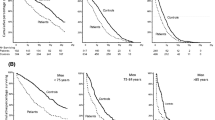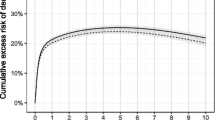Abstract
Background and aims: Identifying predictors for mortality following hip fracture is essential in order to improve survival, especially among the elderly. We compared mortality after hip fracture to controls without hip fracture, and assessed the impact of comorbidity on mortality following hip fracture in a population-based cohort study. Methods: The health care databases in Western Denmark (1.4 million inhabitants) were used to identify all persons ≥40 years of age with first-time hospitalization for hip fracture between 1/1/1998 and 1/31/2003. Five population controls without hip fracture were matched to hip fracture patients on age and gender. Prior hospitalization for selected comorbidities among hip fracture subjects was assessed from hospital discharge registries. Cox regression analysis was used to compute crude and adjusted relative risks and 95% confidence intervals for 30-day, 90-day, and 1-year mortality associated with hip fracture, and with prior hospital history of selected comorbidities. Results: The cohort was followed for an average of 22 months. Females comprised 71 % of the cohort and 90% was aged 65 years or older. Compared to persons without hip fracture, persons with hip fracture had from 2 to >3-fold higher risk of death at 1 year. History of congestive heart failure (CHF), chronic obstructive pulmonary disease (COPD), dementia, tumor, and malignancy increased adjusted 1-year mortality from 50% to 3-fold among persons with hip fracture. Conclusions: Hip fracture increased 1-year mortality more than 3-fold compared with mortality without hip fracture. Among hip fracture subjects, the presence of selected comorbidities further increased the risk of mortality after hip fracture.
Similar content being viewed by others
References
Samelson E, Zhang Y, Kiel DP, Hannan MT, Felson DT. Effect of birth cohort on risk of hip fracture: Age-specific incidence rates in the Framingham Study. Am J Public Health 2002; 92: 858–62.
Cooper C, Campion G, Melton III LJ. Hip fractures in the elderly: A world-wide projection. Osteoporos Int 1992; 2: 285–9.
Gullberg B, Johnell O, Kanis JA. Worldwide projections for hip fracture. Osteoporos Int 1997; 7: 407–13.
Wolinsky F, Fitzgerald JF, Stump TE. The effect of hip fracture on mortality, hospitalization, and functional status: A prospective study. Am J Public Health 1997; 87: 398–403.
Empana J, Dargent-Molina P, Breart G for the EPIDOS Group. Effect of hip fracture on mortality in elderly women: The EPIDOS Prospective Study. J Am Geriatr Soc 2004; 52: 685–90.
Roche J, Wenn RT, Sahota O, Moran CG. Effect of comorbidities and postoperative complications on mortality after hip fracture in elderly people: prospective observational cohort study. BMJ 2005; 331: 1374–6.
Johnell O, Kanis, JA, Odén, et al. Mortality after osteoporotic fractures. Osteoporos Int 2004; 15: 38–42.
Farahmand B, Michaëlsson K, Ahlbom A, Ljunghall S, Baron JA. Survival after hip fracture. Osteoporos Int 2005; 16: 1583–90.
Magaziner J, Simonsick EM, Kashner TM, Hebel JR, Kenzora JE. Excess mortality attributable to white women age 70 or older. Am J Pub Health 1997; 87: 1630–6.
Poor G, Atkinson EJ, O’Fallon WM, Melton LJ. Determinants of reduced survival following hip fracture in men. Clin Orthop 1995; 319: 260–5.
Meyer H, Tverdal A, Falch JA, Pedersen JI. Factors associated with mortality after hip fracture. Osteoporos Int 2000; 11: 228–32.
Nettleman M, Aisip J, Schrader M, Schulte M. Predictors of mortality after acute hip fracture. J Gen Intern Med 1996; 11: 765–7.
Barrett J, Baron JA, Beach ML. Mortality and pulmonary embolism after fracture in the elderly. Osteoporos Int 2003; 14: 889–94.
Gijsen R, Hoeymans N, Schellevis FG, Ruwaard D, Satariano WA, van den Bos GAM. Causes and consequences of comorbidity: A review. Am J Clin Epidemiol 2001; 54: 661–74.
de Luise C, Lanes SF, Jacobsen J, Pedersen L, Sørensen HT. Cardiovascular and respiratory hospitalizations and mortality among users of tiotropium in Denmark. Eur J Epidemiol 2007; 22: 267–72.
Sørensen H. Regional administrative health registries as a resource in clinical epidemiology. Int J Risk Safety Med 1997; 10: 1–22.
Andersen T, Madsen M, Jørgensen J, Mellemkjoer L, Olsen JH. The Danish National Hospital Register. A valuable source of data for modern health sciences. Dan Med Bull 1999; 46: 263–8.
Charlson M, Pompei P, Ales KL, MacKenzie CR. A new method of classifying prognostic comorbidity in longitudinal studies: development and validation. J Chronic Dis 1987; 40: 373–83.
Pedersen C, Gøtzsche H, Møller JØ, Mortensen PB. The Danish Civil Registration System. Dan Med Bull 2006; 53: 441–9.
Gaist D, Hallas J. The Danish prescription registries. Dan Med Bull 1997; 44: 445–8.
Capella D. Drug Utilization Studies: Methods and Uses (Descriptive tools and analysis). In Dukes M, ed. Copenhagen: WHO Regional Publications; 1993.
SAS Institute Inc. SAS, version 9.1. Cary, NC.
International Osteoporosis Foundation. Osteoporosis in Europe- a new report tracks the road to progress. 2005 [updated 2005; cited Dec. 3, 2007]; Available from: http://www.iofbonehealth.org/iofarticles/article-detail.html?articleID=24.
De Laet C, Pols HAP. Fractures in the elderly: epidemiology and demography. Balliere’s Clin Endocrinol Metab 2000; 14: 171–9.
Gross C, Zhenchao G, McAvay GJ, Allore HG, Young M, Tinetti ME. Multimorbidity and survival in older persons with colorectal cancer. J Am Geriatr Soc 2006; 54: 1898–904.
Verbrugge L. Women, men and osteoarthritis. Arthritis Care Res 1995; 8: 212–20.
Ettinger W, Davis MA, Neuhaus JM, Mallon KP. Long term physical functioning in persons with knee osteoarthritis from NHANES I: Effects of comorbid medical conditions. J Clin Epidemiol 1994; 47: 809–15.
Verbrugge L, Lepkowski JM, Imanaka Y. Comorbidity and its impact on disability. Milbank Q 1989; 67: 450–84.
Fried L, Bandeen-Roche K, Kasper JD, Guralnik JM. Association of comorbidity with disability in older women: the Women’s Health and Aging Study. J Clin Epidemiol 1999; 52: 27–37.
Newschaffer C, Bush TL, Penberthy LE, Belantoni M, Helzlsour K, Diener-West M. Does comorbidity interact with cancer? An epidemiologic analysis of mortality in a cohort of elderly breast cancer patients. J Gerontol 1998; 53: M373–8.
de Groot V, Beckerman H, Lankhorst GJ, Bouter LM. How to measure comorbidity. A critical review of available methods. J Clin Epidemiol 2003; 56: 221–9.
Deyo R, Cherkin DC, Ciol MA. Adapting a clinical comorbidity index for use with ICD-9-CM administrative databases. J Clin Epidemiol 1992; 45: 613–9.
Baron JA, Lu-Yao G, Barrett J, McLerran D, Fisher ES. Internal validation of Medicare claims data. Epidemiol 1994; 5: 541–4.
Fisher E, Whaley, FS, Krushat, et al. The accuracy of Medicare’s hospital claims data: progress has been made, but problems remain. Am J Public Health 1992; 82: 243–8.
Rothman K, Greenland S. Modern Epidemiology, 2nd ed. In Rothman K, Greenland S, ed. Philadelphia: Lippincott-Raven: 1998.
Author information
Authors and Affiliations
Corresponding author
Rights and permissions
About this article
Cite this article
de Luise, C., Brimacombe, M., Pedersen, L. et al. Comorbidity and mortality following hip fracture: a population-based cohort study. Aging Clin Exp Res 20, 412–418 (2008). https://doi.org/10.1007/BF03325146
Received:
Accepted:
Published:
Issue Date:
DOI: https://doi.org/10.1007/BF03325146




